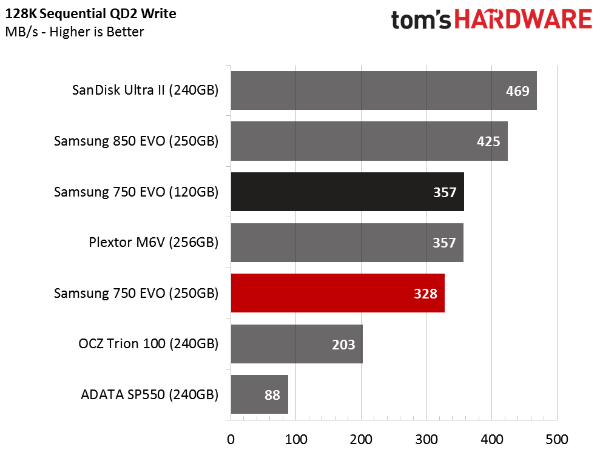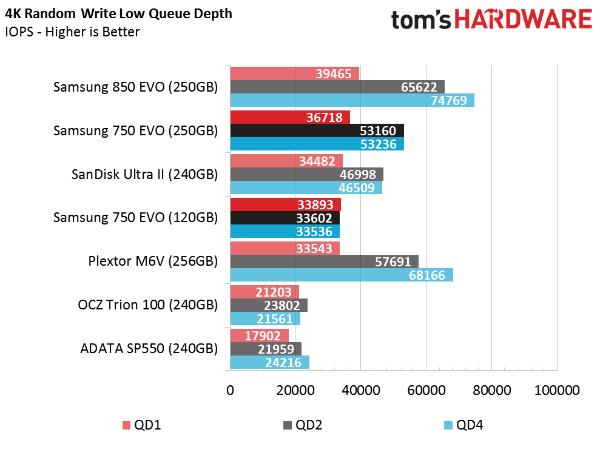Samsung 750 EVO SSD Review
Why you can trust Tom's Hardware
Performance Testing
Comparison Products
Nearly all of the drives in our comparison charts utilize TLC NAND with write enhancement mechanisms to deliver high burst speeds that are not sustainable for more than a few seconds.
Samsung's SSD 850 EVO is the current mid-range performance leader. Its quad-plane TLC flash breaks the mold and delivers longer sustained write speeds than other TLC-based drives with flash from Toshiba and Micron. The Plextor M6V is a newer model that uses the same approach as the Reactor. It comes equipped with the same SMI SM2246EN controller, but pairs it with Toshiba's 15nm MLC NAND.
To read about our storage tests in-depth, please check out How We Test HDDs And SSDs. Four-corner testing is covered on page six of our How We Test guide.
Sequential Read Performance


Even with eight levels of charge to sort through, nearly every drive hits the SATA interface's maximum performance level. As always, queue depth is important to consider, and we see more performance variation at the low queue depths encountered on a daily basis.
Samsung's 750 EVO 250GB outperforms the 850 EVO, though the results indicate only a slight difference between both products. The 120GB 750 EVO does give up some sequential read speed at low queue depths compared to the other Samsung drives, but that's to be expected since it's working with half as many flash dies.
Sequential Write Performance



Samsung's TurboWrite algorithm performs well in our tests, even though we don't leave a lot of time for the buffer to flush between runs. Many competing products show up as waves, since they struggle to flush the emulated SLC buffer data to much slower TLC.
The third image illustrates the large block size sequential roll-off and sustained sequential write performance. Samsung's 750 EVO maintains writes in excess of 200 MB/s. Until recently, Samsung was the only vendor to hit that level using TLC NAND. Phison has caught up, though, with its direct-to-die write algorithm. We simply don't have a low-capacity Phison S10-based drive to add to our charts.
Get Tom's Hardware's best news and in-depth reviews, straight to your inbox.
The 120GB SSD 750 EVO reaches the same performance in the buffer stage, but writes quickly drop to 140 MB/s after an extended load. TLC's native write speed won't become an issue until you need to send a lot of data to the drive at one time. Installing software and transferring large photo albums are two common examples of when you'd do that.
Random Read



The emulated SLC buffer works to keep random performance high. Even though the SSD 750 EVO should be a very low-cost drive, it still delivers admirable random read results, which is important because most of your data transactions take the form of small-block reads and writes. The trade-off is a hit to endurance, which becomes an issue later in the product's life.
Random Write



The 750 EVO and 850 EVO are separated by write performance. When we test with small blocks of data written randomly, the gap between them grows more than we saw in our sequential tests. Even at low queue depths, the two drives seem pretty similar to each other at any given capacity point. But as the queue depth increases, so does the 850 EVO's edge. Then again, the 250GB 750 EVO responds to our random write workload more favorably than the non-Samsung SSDs we benchmarked.
Current page: Performance Testing
Prev Page Specifications, Pricing, Warranty And Accessories Next Page Mixed Workload And Steady State Testing
Chris Ramseyer was a senior contributing editor for Tom's Hardware. He tested and reviewed consumer storage.
-
SteelCity1981 wow the battery life benchmarks on the 750 EVO is highly impressive, it make the 850 EVO's look power hungry. i wasn't expecting to see that at all esp from a non 3D V-NAND SSD. So if getting the most out of your battery life in your portable pc device is very important to you, then def the 750 EVO is the way to go.Reply -
araczynski Of course they're intending these for system integrators, who get a marketing bullet point at a reduced price, and while their lifespan is inferior, the eventual failures will fall out of the integrator's default warranty period ("not our problem, buy a new one from us"). Personally I think this is a cheap move to milk consumers. Samsung should stick to the middle/high level stuff while they still have a good reputation at quality.Reply -
Gam3r01 ReplyOf course they're intending these for system integrators, who get a marketing bullet point at a reduced price, and while their lifespan is inferior, the eventual failures will fall out of the integrator's default warranty period ("not our problem, buy a new one from us"). Personally I think this is a cheap move to milk consumers. Samsung should stick to the middle/high level stuff while they still have a good reputation at quality.
While I do enjoy recommending Samsung's high end drives, I dont see this as milking customers. I would be more comfortable seeing a 750 evo inside a low budget system than kingston's SSD Now! drives. They saw a market in low cost, cheaper made drives. I am happy to see Samsung moving their old tech into this area. Its not the fastest, nor the highest quality drive, but it fits.
I dont see Samsung's quality reputation getting hurt any time soon. -
phoenix32x I am confused. How is this good/better or useful? The 250GB 850 EVO is quite often available for $80. $5 less for inferior flash with less endurance. I don't get the point I guess.Reply -
Gam3r01 Reply17524941 said:I am confused. How is this good/better or useful? The 250GB 850 EVO is quite often available for $80. $5 less for inferior flash with less endurance. I don't get the point I guess.
I see the price dropping once it becomes available. Otherwise I agree it wont have a place at that price. -
Darkbreeze At twenty bucks less it makes sense, otherwise, it would be worth the extra twenty bucks simply for the longevity. Especially when the Sandisk Ultra II has similar performance to the 850 EVO in most capacities for a lower price.Reply -
joex444 Replywow the battery life benchmarks on the 750 EVO is highly impressive, it make the 850 EVO's look power hungry. i wasn't expecting to see that at all esp from a non 3D V-NAND SSD. So if getting the most out of your battery life in your portable pc device is very important to you, then def the 750 EVO is the way to go.
You're absolutely not wrong that the 750 seems to give about an hour more battery life than the 850 does, but let's remind ourselves that these plots were made starting at 500 minutes not 0 minutes. That's inherently deceptive, and obviously THG would say it's meant to show the variation more clearly, but the fact is that the bar looks like it's 70% longer (170 apparent units versus 105 apparent units), we should divide the values to reveal the true benefit: 10.7%. I may not be that inclined to get up in a tizzy about an extra 10% or an extra hour -- particularly when the 850 already allows 10 hours of usage -- but an extra 70% would be truly outstanding. Alas, that 70% is merely deceptive non-zero starting points on a graph. -
Math Geek endurance is not that bad really unless you try to use it as a torrent drive or something silly like that. during the 3 yr warranty period for the 120 gb drive, you'd have to write 32 GB per day to the drive to reach the 35 TB TBW. sure the initial windows install and program installations will take up a bit of this but once that is done, day to day use won't get anywhere near this number for the average user.Reply
double this amount for the 250 GB drive since it has the same 3 yr warranty but a 70 TBW and you're even further than breaking this threshold. even storing data on it won't do much since this is usually written once and then read over and over. the reading of the data does not go against this TBW rating.


